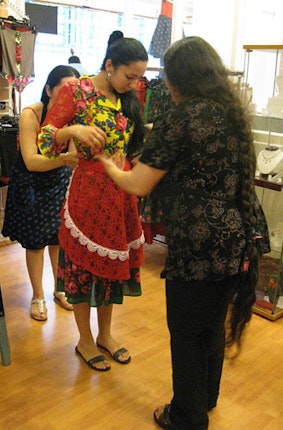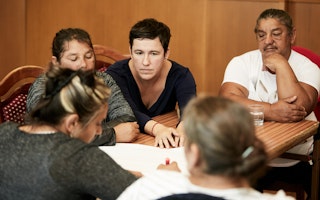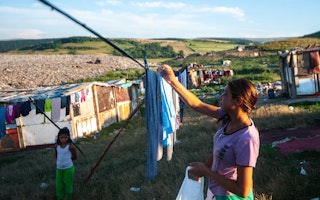Raising Consciousness on the Catwalk
By Andy Haupert
On Saturday evening in a downtown Budapest square, models presented the debut collection of clothing and jewelry from Romani Design, Hungary’s first Roma fashion label, to applause from an audience of invited guests and curious passersby. All of the outfits in the show incorporated or were inspired by traditional Roma clothing items, such as aprons and scarves, and traditional decorative elements—floral patterns, symbols of fortune, and a daring use of color. The handmade silver jewelry worn by the models featured stylized forms of the symbols of fortune—horseshoes, lentils, four-leafed clovers—that are prominent in traditional Roma culture.
Romani Design is the brainchild of Roma jeweler and designer Erika Varga. Although she does not consider herself an activist, Erika has long been involved in promoting Roma culture. After graduating from high school, she worked for several years as an organizer and mentor for Roma youth before becoming a jeweler’s apprentice and then a qualified jeweler. In 2001, with funding from the Open Society Foundations, she founded Glinda (Mirror), an illustrated children’s magazine about Roma history, culture, and language. Largely sustained through the efforts of volunteer artists and authors, the magazine also organizes workshops at which disadvantaged children can try their hand at crafts.
For years Erika dreamed of creating jewelry and clothing based on Roma traditions that would also have appeal for the general public. In 2009, she realized her dream by establishing the Romani Fashion Studio Social Cooperative and its Romani Design brand under a program run by the Hungarian Employment Foundation. (About half of the company’s employees, both Roma and non-Roma, were previously among the long-term unemployed.)
Earlier this summer, as Erika prepared for the show, we spoke in her studio about her dream and the company she hopes will sustain it. “Tradition is an important part of culture, no matter which culture we are talking about,” she said, “I want non-Roma to see that they too can wear Roma jewelry and clothing—reinterpreted and in a form that’s been a bit modernized—and that our traditions call also help them to express themselves.”
“Roma culture and Hungarian culture are not opposites,” she said, “It is important for Hungary to know that our culture is alive, just like Hungarian culture, and—far from being in opposition to each other—the two cultures have nourished each other and can continue to do so. They shouldn’t try to extinguish each other; they can and should enrich one another.”
On a rack nearby hung a Romani Design outfit that in May was used to convey this message when a Roma member of parliament, Ágnes Osztolykán, wore it at the opening session of the newly elected Hungarian parliament, to which the leader of the far-right nationalist Jobbik party (“Movement for a Better Hungary”) defiantly wore the uniform vest of the Hungarian Guard, a banned neofascist paramilitary organization.
When I asked whether it wasn’t quixotic to begin promoting Roma fashion to Hungarian consumers at a time when Hungary was in the news for rising extremism and violence against Roma—a series of attacks in 2008 and 2009 left six Hungarian Roma dead—Erika replied that Romani Design is a communication tool as well as a brand: “Rather than circulating a petition or singing a song of protest, we are using our products to say that we Roma are here in Hungary and we want to be here in the future.”
Until February 2024, Andy Haupert was an associate policy officer for the Roma Initiatives Office.





